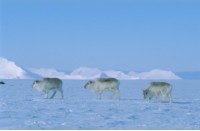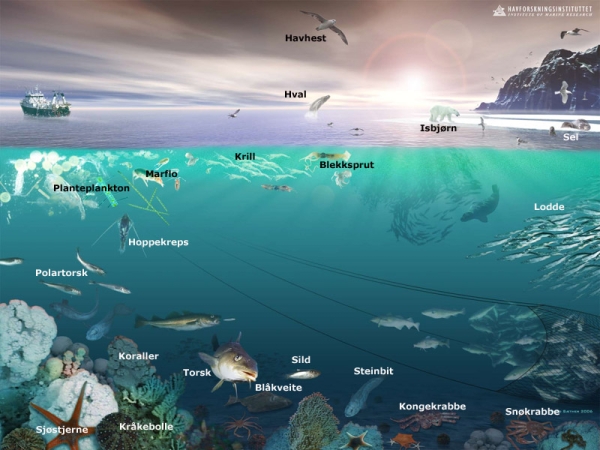Arctic Ltd
 The Svalbard reindeer is a subspecies of the reindeer on the mainland. It is only found in Svalbard and has become adapted to the cold, inhospitable climate by evolving short legs and a relatively short, round head. Its summer coat is brown on the back and light-coloured below. In winter, its coat is more light coloured and frequently light grey or yellowish white. Because of their thick coat, even starved animals seem to be fat, and this also makes the reindeer appear extra short-legged.
Illustration: Ronny Aanes, NPI
The arctic ecosystem may be compared with a business, a major workplace called Arctic Ltd. This is a well-functioning organisation with long traditions. Everyone knows his or her place in the system and contributes to the organisation in his or her own small way – each species is a small piece in the big jigsaw puzzle that, together, makes up the whole picture.
The Svalbard reindeer is a subspecies of the reindeer on the mainland. It is only found in Svalbard and has become adapted to the cold, inhospitable climate by evolving short legs and a relatively short, round head. Its summer coat is brown on the back and light-coloured below. In winter, its coat is more light coloured and frequently light grey or yellowish white. Because of their thick coat, even starved animals seem to be fat, and this also makes the reindeer appear extra short-legged.
Illustration: Ronny Aanes, NPI
The arctic ecosystem may be compared with a business, a major workplace called Arctic Ltd. This is a well-functioning organisation with long traditions. Everyone knows his or her place in the system and contributes to the organisation in his or her own small way – each species is a small piece in the big jigsaw puzzle that, together, makes up the whole picture.
The big guns at the top, the polar bear, the seal and the whale, are often the public face of the organisation, but they certainly do not control the firm alone. They are at the mercy of the workers beneath them and must depend upon them for their own existence.
The ecosystem in the Arctic is characterised by short food chains involving few species, i.e. there are few links from the plants lowermost in the chain to the predators at its top. The Arctic is therefore also a vulnerable organisation. Should something go wrong in one chain, there are not many alternative sources of food for those living in the chain above. However, even though the diversity of species is low, it is a large organisation and each species may be represented by several million, perhaps billion, individuals. This especially holds true for species that are far down in the food chain, but the number of individuals per species decreases towards the top.
Arctic Ltd is a conservative, old-fashioned and traditional workplace that has functioned in the same manner for thousands of years. Things take time here and, compared with companies in warmer regions, many processes go much more slowly in Arctic Ltd. Many organisms here grow more slowly, they reach a sexually mature age later and they have fewer offspring than more southerly species. On the other hand, they live for quite a long time, as exemplified well by the fulmar among the birds and the bowhead whale. The fulmar may live for 50 years, while the bowhead whale can reach the ripe old age of nearly 250 years, longer than any other mammal in the entire world. More energy is consumed to maintain heat and to survive in the Arctic than is the case among organisms living in warmer regions, so there is less surplus to be used for reproduction. It may be said that the cold leads to birth control and delays the aging process.
As Arctic Ltd is a slightly old-fashioned organisation, it may respond poorly to change. Changes are generally forced upon it by external constraints, non-biological pressures, which lay the basis for the existence and development of the firm – for better or for worse.
The climate is a factor that lays severe premises for life in the Arctic, and the increasingly warmer climate is now posing great challenges for Arctic Ltd. The ice is retreating and is threatening to literally pull the ground from under the feet of the firm. Together with the ever-rising temperatures, southerly species are moving into the region and threatening to take over the headquarters. New species may also bring viruses and bacteria that have not previously been able to survive in the cold North, and the Arctic staff may be exposed to diseases against which they lack immune response.
Moreover, as if this were not enough, Arctic is also fighting hazards on several fronts. Together with rapid changes in climate and human activities like fishing, pollutants are the worst menace and are now threatening to destroy the organisation from the inside. They accompany the food chain and are taken up by the very smallest organisms, accumulate upwards and affect the ability for survival and reproduction at the top of the food chain.
 The Barents Sea ecosystem is an Arctic marine food-chain that starts with the smallest photosynthesizing organisms in the sea. They are followed by the organisms that eat plant-material, and at the top of the chain are carnivore organisms. The food-chains in the Arctic are short, with relatively few joints from the organisms at the bottom to the Polar bear at the top, but even though the chain is short, millions of organisms from the same species may form one joint. This illustration is available as a poster. To order one, please send an e-mail to the Institute of Marine Research: post@imr.no.
The Barents Sea ecosystem is an Arctic marine food-chain that starts with the smallest photosynthesizing organisms in the sea. They are followed by the organisms that eat plant-material, and at the top of the chain are carnivore organisms. The food-chains in the Arctic are short, with relatively few joints from the organisms at the bottom to the Polar bear at the top, but even though the chain is short, millions of organisms from the same species may form one joint. This illustration is available as a poster. To order one, please send an e-mail to the Institute of Marine Research: post@imr.no.
Illustration: The Institute of Marine Research